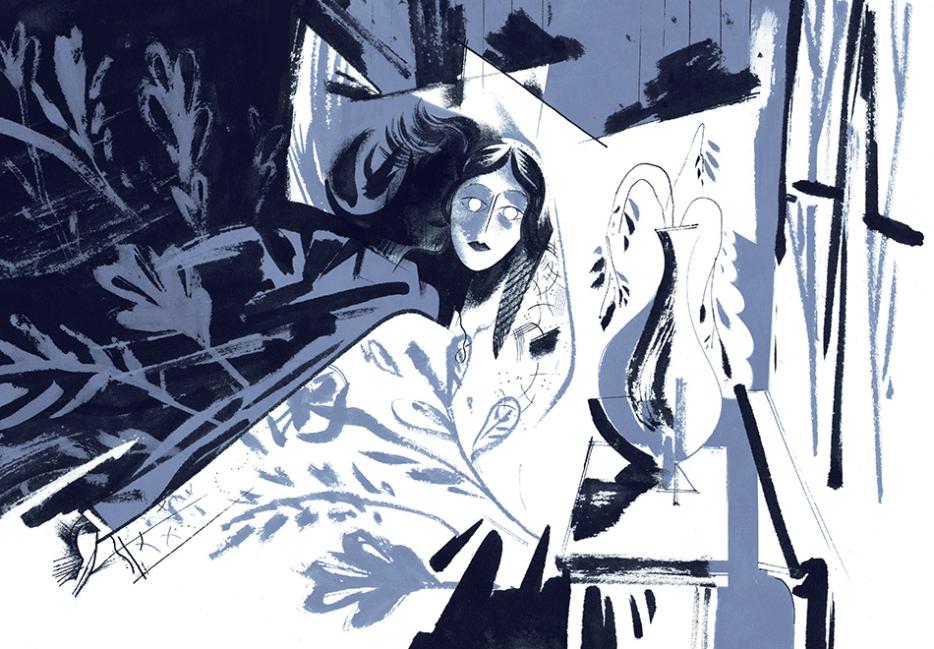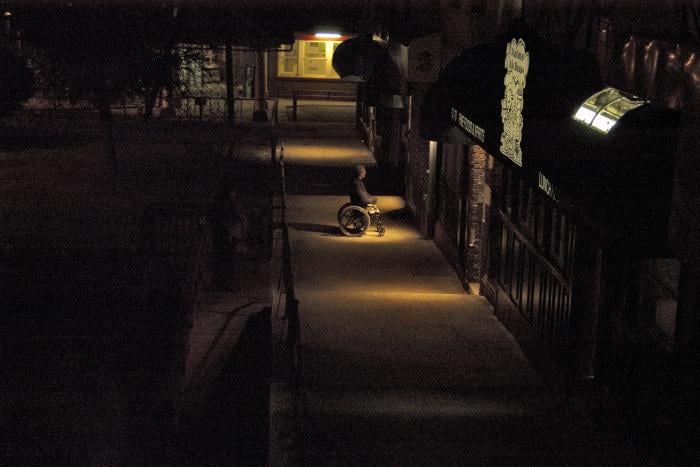On an exterior wall of St. Sebastián’s church in Madrid, there’s a little tile sign dedicated to a poet. “In this church,” it reads, “Lope de Vega Carpio was buried in the year 1635.” The sign is decorated with a sketch of the church to which it’s affixed, showing the building in its pre-1930s state, before bombs leveled it during the Spanish Civil War. The shape of the building is still recognizable, but it’s drawn from the back and features a cemetery where an outdoor flower shop stands today. There is something funereal that clings to that flower shop. It’s in the black iron fence and the floral arrangements. It’s in the new black sign arching over the entrance that says, “Never stop dreaming.” A harmless cliché, but once you know the history of the place, it reads like a memo to the bodies once buried below. Never stop dreaming. Please, don’t let anyone disturb you from your eternal sleep.
María Ignacia Ibáñez was a body who should’ve stayed at rest. She was buried here, at St. Sebastián’s, in 1771, after dying of typhoid at the age of twenty-five. She was a famous actress in Madrid, but despite her success, she didn’t get a little sign like Lope de Vega; she isn’t even included in the church’s list of notable deaths next to other artists, architects, and writers. But this is unsurprising: the church would probably like to forget about her, her gravesite, and most of all, her boyfriend, José Cadalso. This is thanks to Cadalso’s prose poem, Noches Lúgubres (Lugubrious Nights), which he wrote after her death. It’s the story of a man just like himself who breaks into a cemetery just like St. Sebastián’s and attempts to dig up the corpse of a woman just like Mariá Ignacia.
Lugubrious Nights was a grisly piece of writing, but it was also an influential one; if Cadalso began work on it the same year as María Ignacia’s death, as some scholars speculate, then it was easily the first piece of Romantic literature in continental Europe, preceding even Goethe’s sturm und drang classic The Sorrows of Young Werther. Cadalso’s gloomy body snatcher could also be seen as the first Byronic hero, years before Lord Byron was a gleam in his father, Mad Jack’s, eye. But despite the fact that Lugubrious Nights was ahead of its time, it wasn’t quite as innovative as it seemed. A subtitle from some early editions hints at this: Imitating the Style of those that Dr. Young Wrote in English.
And in this case, style didn’t simply refer to form. Dr. Young’s poem featured a familiar plot line: a man, very much like the author, breaking into a cemetery.
Grief Changes a Man
The Reverend Dr. Edward Young was an English poet, but not only was he not a Romantic, he also wasn’t the type of fiend who would make a hobby out of pilfering bodies from cemeteries. It’s true that, as a student, he blacked out his windows and worked by candlelight radiating from a human skull, but he saw this proclivity as artistic Adderall, the work-habit of a bona fide poet that could help him catch up after slacking off at school. As an adult he outgrew his goth phase, settling in as a serious Protestant and even becoming a royal chaplain, his poetry evolving in the Neoclassical style. Etchings of him show a Hostess Donette of a man—a white powdered wig on a doughy face, sitting on a doily cravat. His body of work mostly featured poems with long, fawning dedications to patrons who always seemed to go broke just after hiring him. (An embarrassing habit—as Jonathan Swift quipped, “Young must torture his invention/To flatter knaves, or lose his pension.”)
Which is how Young likely would’ve been remembered, and quickly forgotten, had he not confessed:
With pious sacrilege, a grave I stole,
With impious piety, that grave I wrong’d
Short in my duty, coward in my grief,
More like her murderer than friend, I crept
He wrote those lines in The Complaint: or, Night-Thoughts on Life, Death, and Immortality (commonly called Night Thoughts), which he published in nine parts called “nights” from 1742 to 1745. This passage comes from the poem’s famous third night, wherein Young writes himself in as a man who breaks into a cemetery with the corpse of a young woman named Narcissa in tow. Alone and distraught, he buries the mysterious woman secretly in another man’s grave.
Night Thoughts is a classic example of Graveyard Poetry, a movement mostly remembered as a brief stop along the way to Romanticism when otherwise dull Neoclassicists took to the cemeteries. (It was a genre tailor-made for Edward Young. One hopes he kept his skull in storage for just such an occasion.) But while the gloomy backdrop was new, the poetry itself was rather conservative. Night Thoughts is a 10,000-line meditation on death, written in blank verse, draped in classical allusion and decorated with righteous Christian thoughts about resurrection. There’s little in the way of narrative, so the dozen-or-so lines in which Young describes sneaking into the cemetery are surprisingly cinematic—so much so that they inspired a popular painting by Pierre-Auguste Vafflard. In the painting, Young looks like a different man entirely; he’s gaunt but strong, pallid in the moonlight with fashionably tousled hair, not a powdered wig in sight. His arms clasp around a woman so stiff and pale she seems carved out of marble. In this painting, it’s easy to see why, from Night Thoughts on, Young was no longer considered second-rate, no longer a punch line: A dead woman lent him the gravitas he craved; she revamped his image and secured his place in literary history. No wonder, then, that José Cadalso wanted to imitate Young’s style nearly fifty years later.
For all Cadalso’s claims of imitation, there’s a glaring difference between his Lugubrious Nights and Young’s Night Thoughts, even if you overlook the difference between Young’s blank-verse meditation and Cadalso’s plot-driven prose: Cadalso’s fictional proxy, Tediato, doesn’t come to the cemetery to bury his unnamed lover—he comes ready to dig her up. And while Young keeps his “sacrilege pious,” Tediato’s post-exhumation plans start with taking the corpse to bed. At the end of Cadalso’s first night (borrowing Young’s structural device), Tediato takes a moment to address his lover’s body, which remains buried despite his efforts:
“Oh you, image now of what I shall be shortly; soon I shall return to your tomb, I will take you home with me, you will rest on a bed next to mine; my body will die next to yours, adored cadaver. Expiring I will set my domicile on fire, and you and I will turn into ashes in the midst of those of the house.”
People immediately found it suspicious that Cadalso, a man grieving the sudden death of his girlfriend, would write a poem that included such a bizarrely specific plan: dig up his lover, get the corpse into bed, commit suicide, then somehow self-cremate by setting the house on fire. He had to be thinking of María Ignacia when he wrote that passage. So when Cadalso referred to his poem’s “true part” in a letter to a friend, it seemed like he confessed to what many assumed to be true: That, fueled by grief, or more likely a heroic amount of booze, Cadalso broke into the cemetery at St. Sebastián’s and tried to exhume María Ignacia’s corpse.
Though both The Deceased was Petitioned and Lugubrious Nights deal in dead women, the former is rather quaint compared to the latter. In de Vega’s version, the girl’s resurrection seems to have a halo sketched around it, a hopeful shine that only a true believer would include. De Vega was, in fact, a devout Catholic. He believed in the supernatural powers of the Church and often re-told miraculous stories that were passed down to him through ballads and folklore. For this reason, de Vega is often compared to his contemporary, Shakespeare, since both writers used plots from existing sources. But de Vega’s writings are also indebted to hagiography. Like the writers who recorded the lives of the saints, he was more interested in truthfully documenting the wonder of the world than the reality of it. These priorities were understood during his time, but today they strike most readers as false. Modern audiences have yet to untangle themselves from the insistence on psychological realism and the concept of authenticity the Romantics demanded—which is exactly what Cadalso offered in addition to his fascination with Catholic rituals.
There is a pervasive, if morbid honesty in Lugubrious Nights, particularly in Cadalso’s willingness to record his own dark thoughts and his affinity for observing nature—even to the point of imagining maggots in the body of his lover. In the poem, Tediato exclaims:
“Into these worms, oh! Into these your flesh has been turned! From your once beautiful eyes these sickening creatures have been engendered! Your hair, which in the height of my passion I called a thousand times not only more blond but more precious than gold, has produced this rot. Your white hands, your loving lips have turned into matter and decay!”
But perhaps Cadalso’s honesty is most apparent, and most sympathetic, in the way he paints Tediato as someone drawn to the traditions of the Church long after his faith in God has been irrevocably shaken by rationalism.
This rationalism was noted by none other than the Spanish Inquisition in Córdoba, who banned Lugubrious Nights in 1819. They objected to Tediato’s planned suicide and the fact that he never fears hell; Tediato’s omission of the Catholic afterlife becomes particularly obvious when he rejects the idea of a secular afterlife altogether. When his gravedigger-accomplice retreats, fearing ghosts in the cemetery, Tediato suddenly sounds like a modern skeptic:
“What’s frightening you is your very own shadow together with mine. They are produced by the position of our bodies with respect to that lamp.”
In other words, death is not just real to him, but final. Tediato (and therefore Cadalso) stared into the void without a supernatural glimmer of hope.
As Mario Praz wrote in his book The Romantic Agony, a Romantic is interested in the natural monstrosities and aberrations of our world. And like a true Romantic, Cadalso was only interested in the observable—the natural and psychological aspects of death instead of the supernatural. A good Catholic in his day would fear an eternity in hell for that, but perhaps Cadalso was punished in another way. Unlike more devout writers like Lope de Vega or even Edward Young, Cadalso’s agnostic grief continues to ring true in the modern world—so much that people have mistaken it for literal truth for over two centuries now.
A Gentleman’s Stiff
The subtle nihilism of Lugubrious Nights feels modern, but there’s one detail that would certainly change if the story were told today: Cadalso is never clear if Tediato succeeds in digging up his lover’s body. On the first night he runs out of time, on the second he’s waylaid by the police. The third ends enigmatically when he meets his gravedigger-accomplice one last time and says:
“You will contribute more to my happiness with that pick, that mattock… vile instruments in the minds of others… venerable in mine… Let’s go friend, let’s go.”
That’s the end, ellipses and all. There’s no climax. No one witnesses the consummation of Tediato’s nightmarish plan nor his anguished failure.
The fact is, Cadalso can’t give us what we’re looking for. His outlook was bleak enough to imply that Tediato’s happiness could only be found with the gravedigger’s tools—a pick and a mattock—but he can’t quite bring himself to elaborate. Like later Romantics, he concerns himself with longing but not satisfaction. Satisfaction in this case would require the reader to want to see the last grim scene between Tediato and his lover’s corpse. And that desire could be called sadistic. Those whose tastes lean in that direction only need to look as far as the most obvious source—the Marquis de Sade, who couldn’t resist rewriting de Vega and Young and Cadalso’s tale one more time in Juliette. But unlike Romantic Cadalso, he could do so with the promise of satisfaction, no matter how perverse. And so the dead woman shifts again: from pious saint to romantic obsession to object of decadence.
The Marquis borrowed his setting from Lope de Vega: an Italian church where a shrouded young woman awaits burial. From Edward Young he borrowed the character of the bereaved father. Then, in his own inimitable style, he combined that character with José Cadalso’s distraught lover. This man, Cordelli, bribes the gravedigger for some time alone in the church before his daughter’s vault is sealed.
Once he’s alone, Cordelli incestuously embraces the girl, though she doesn’t revive like she would in one of Lope de Vega’s plays. (Sadism and decadence, being vagaries of Romanticism, require a certain degree of naturalism.) The permanence of the girl’s death is for the best anyhow: The scene devolves into a long and bloody orgy, the details of which can be found around page 1,046. There is no passage to reasonably quote.
The novelist Joris-Karl Huysmans once said that sadism is the bastard of Catholicism—a direct descendent, but an embarrassing byproduct of its ecstasies. Cadalso may have preferred to end his poem before creating such an abomination, but Catholicism kept influencing writers long after him, eventually ushering in the likes of de Sade and the Decadents who were happy to pick up where he left off. Like Cadalso, they were inspired by the martyrs and their objectified bodies in crystal caskets—they just also had a predilection for the tortures that put them there in the first place.
There’s no turning back in this evolving story of the beautiful dead girl. The literary tradition that bubbles up from beneath that funereal flower shop at St. Sebastián’s continues today. Like Tediato, modern audiences still find happiness in picks and mattocks, and have access to de Sade’s racks and knives as well. We put them into constant use in the latest gritty cable crime-drama, providing the latest dead girl with her arched back, rolled eyes, clenched fists, and unwilling willingness. It’s a work-around. It provides a one-sided kind of sex—a necessity, because Catholicism’s persistent influence ensures we still love virgin-martyrs the very best. Like de Vega, Cadalso, Young, and de Sade, we’re still hauling out their bodies, filling up our reliquaries, and making new adored cadavers.






